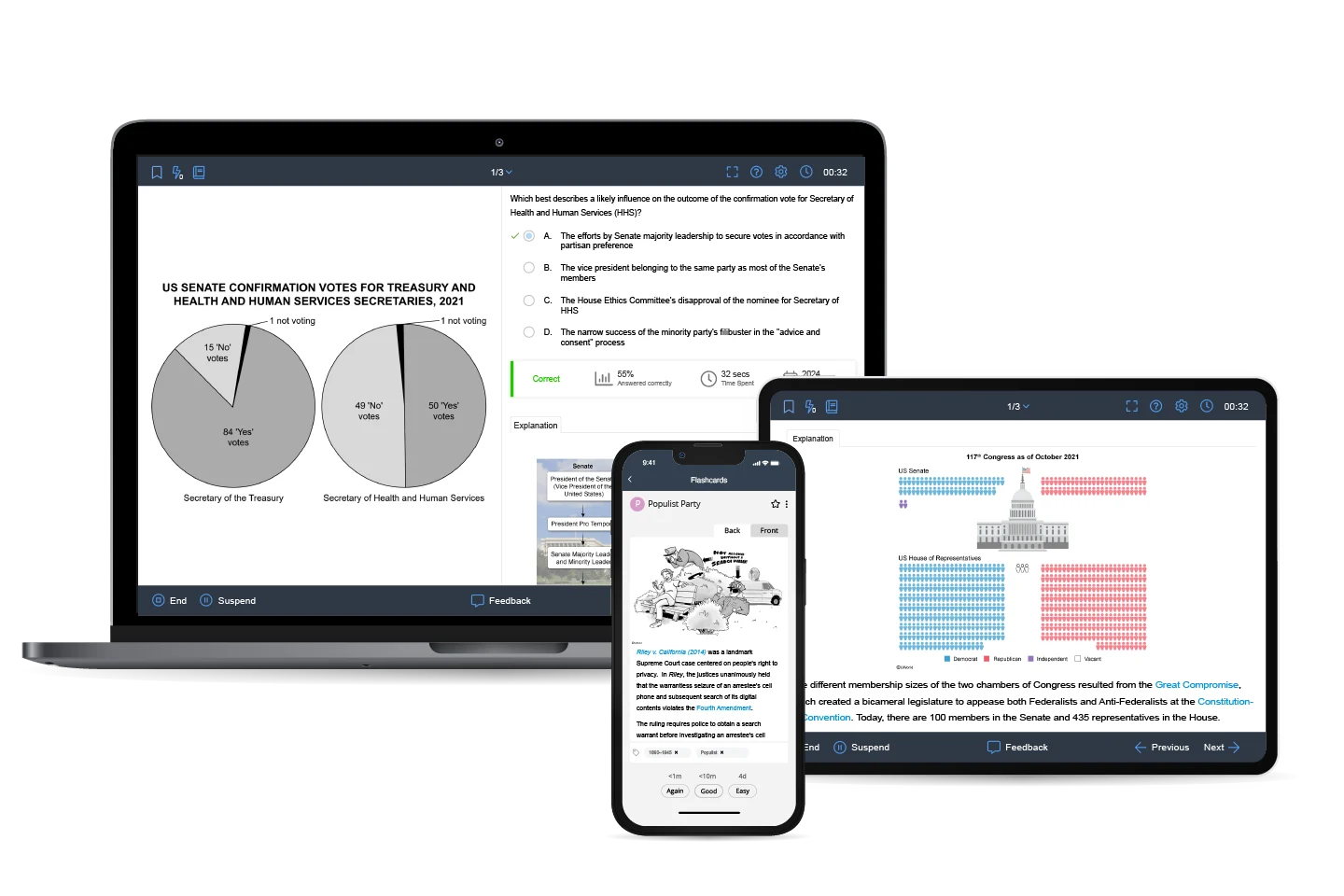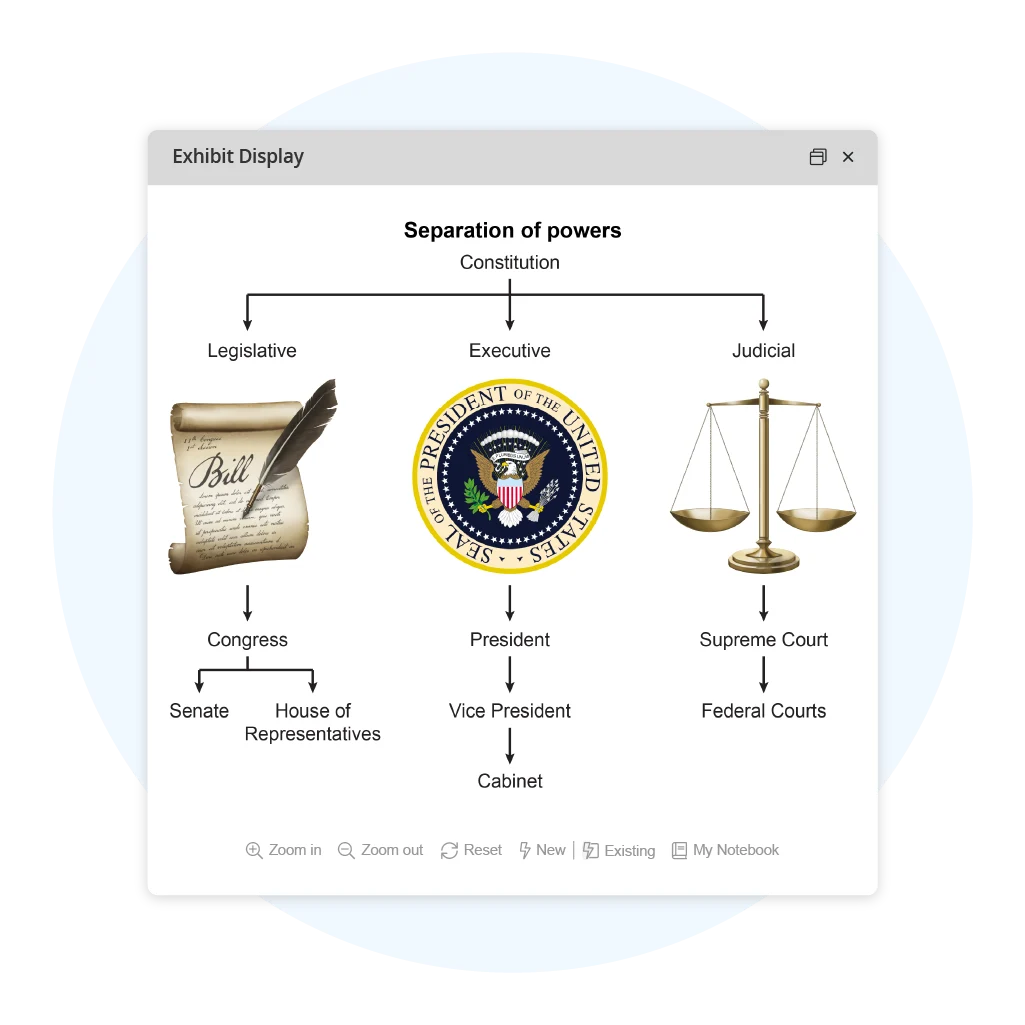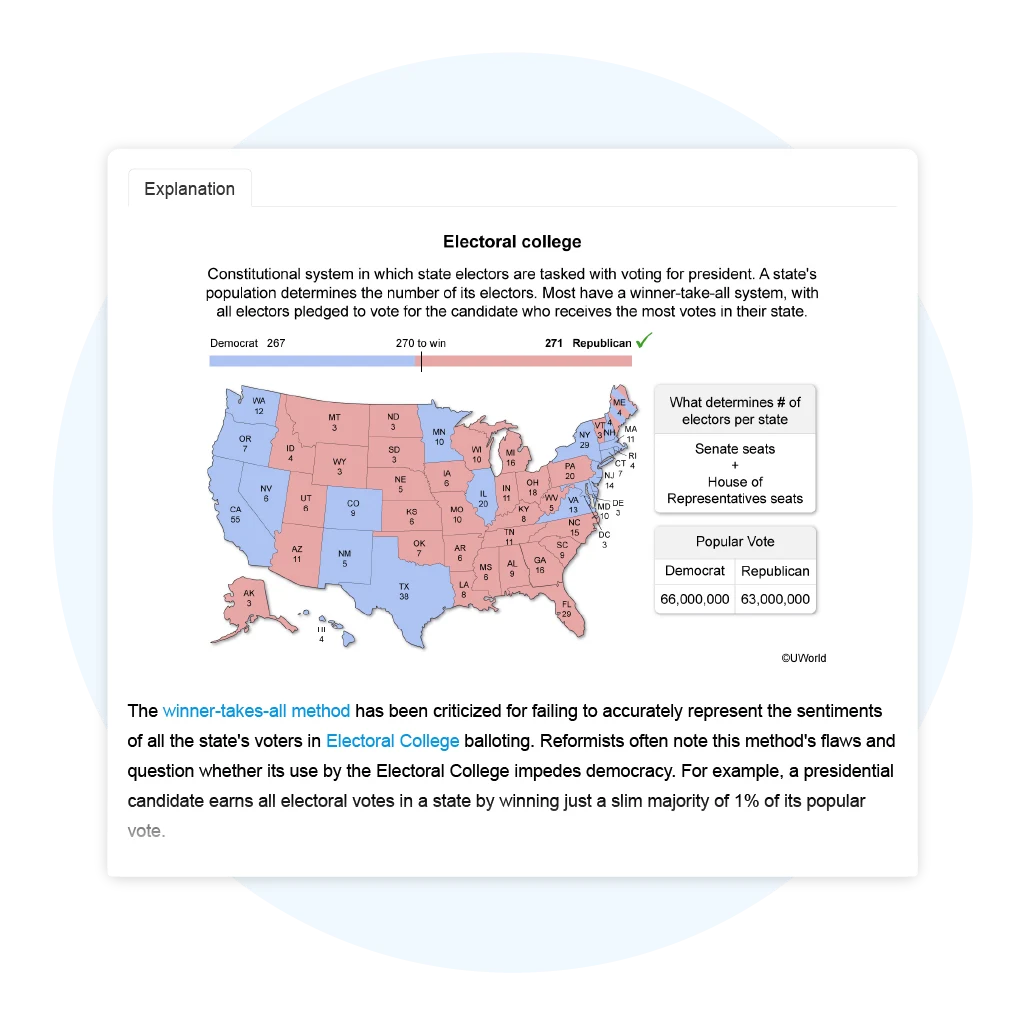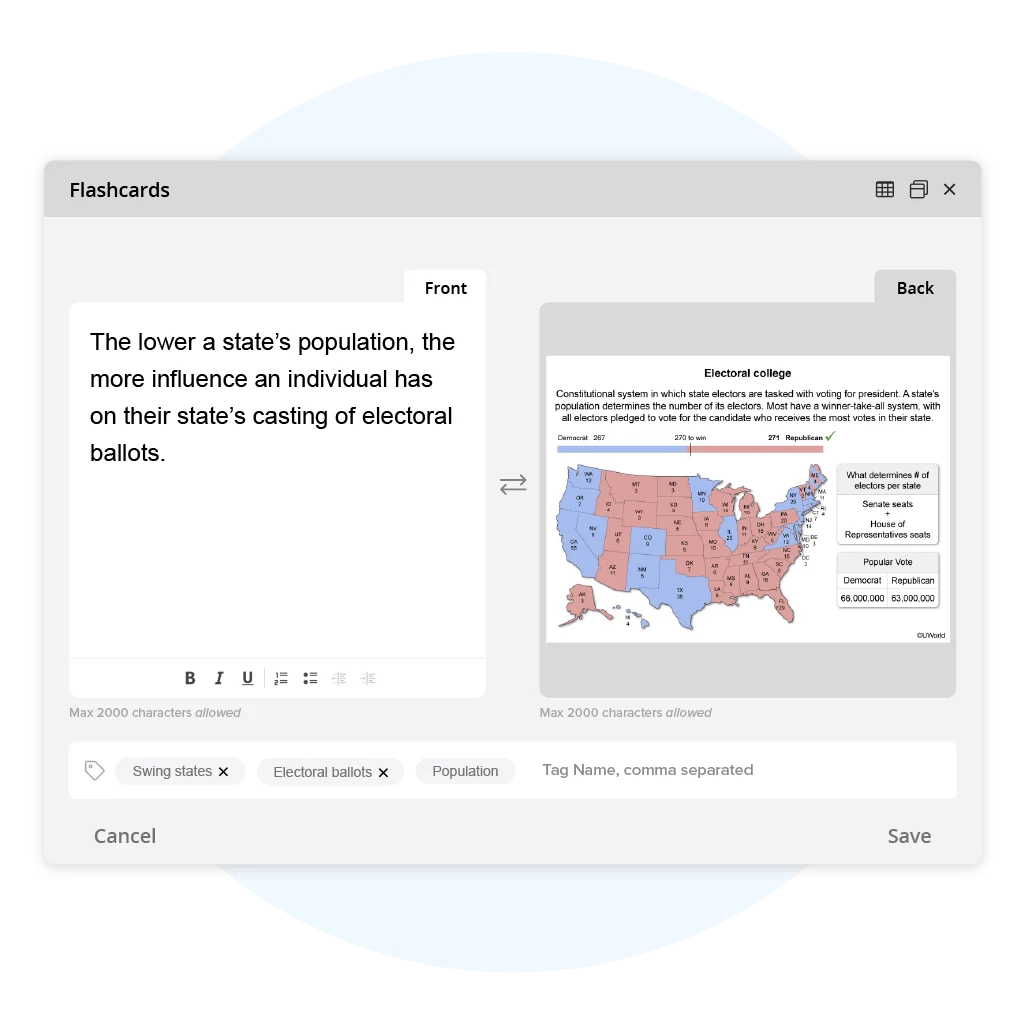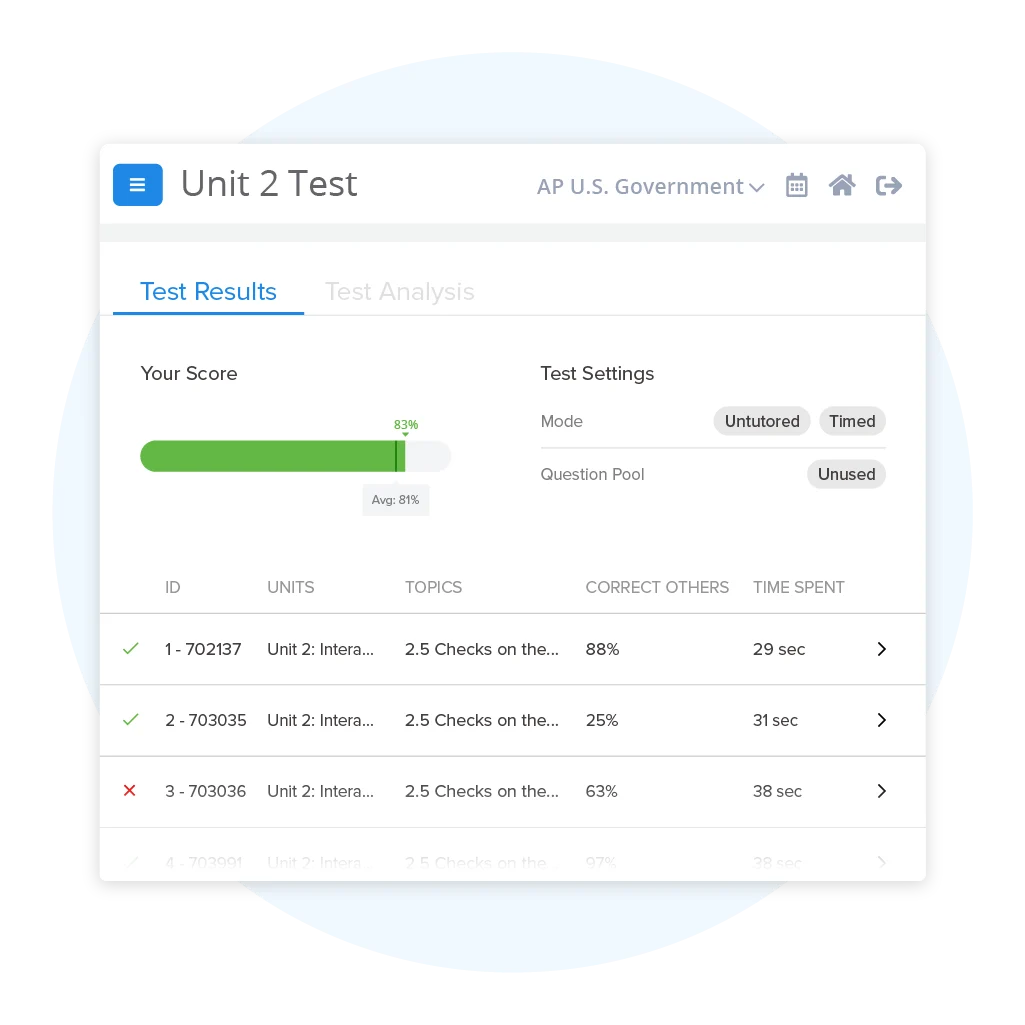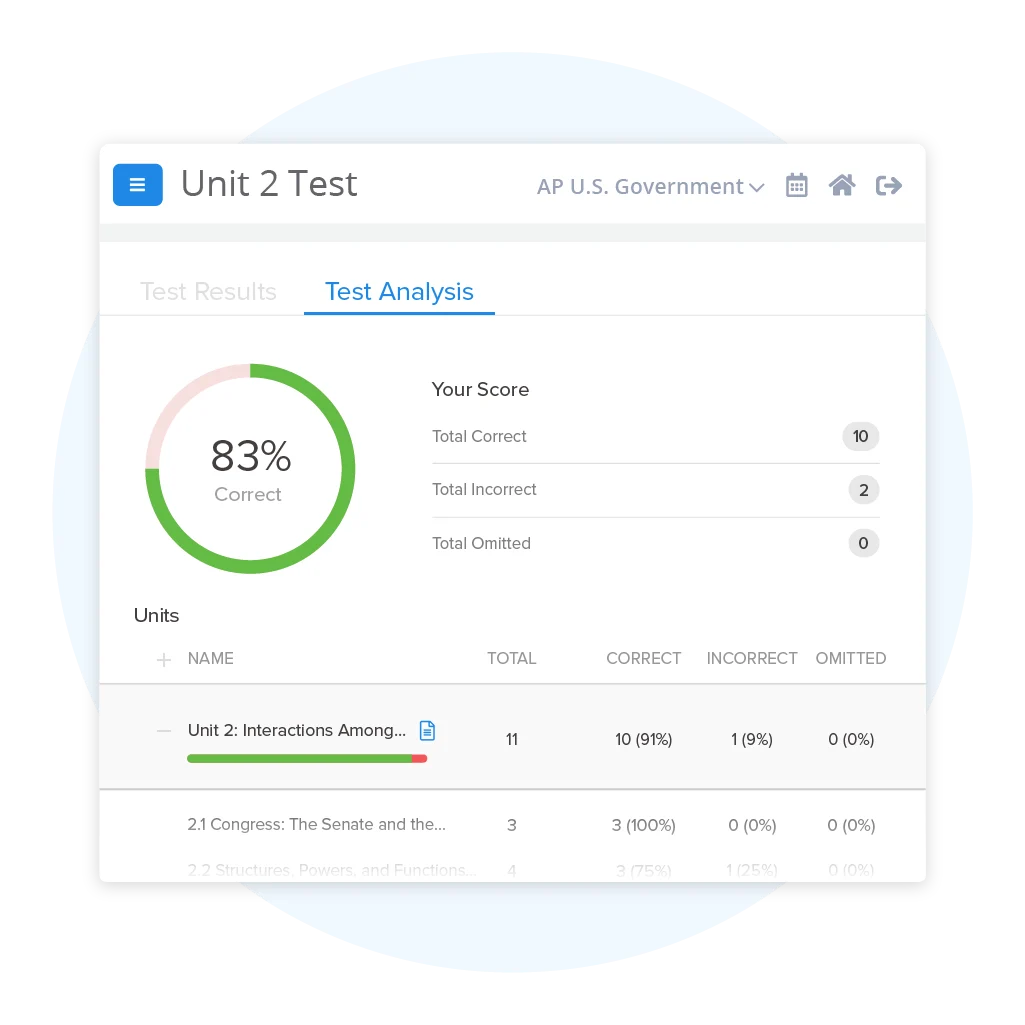Access Includes
- 250+ Exam-style Practice Questions
- Customizable Quiz Generator
- Realistic Timed Test Simulation
- Colorful Visual Explanations
- Step-by-Step Solutions
- Adjustable Smart Study Planner
- Progress Dashboard
- Smart Flashcards
Try These AP Government Practice Test Questions
Foundations of American Democracy Practice Test
Question
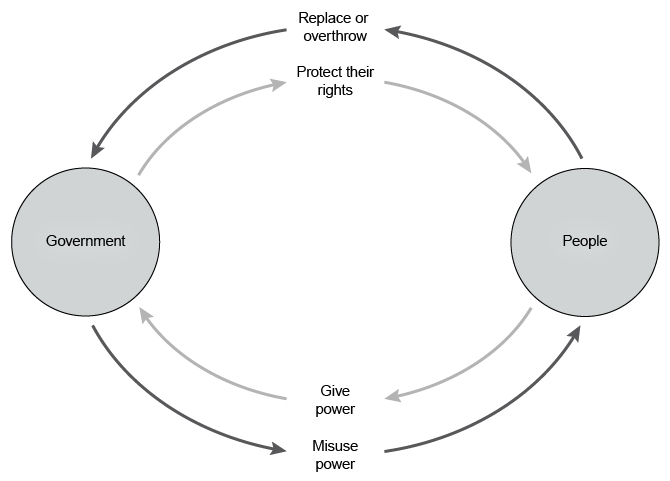
Which of the following statements best explains the diagram?
| A. Federalism is the most effective form of governance for large countries | |
| B. Governments exist to protect the rights of the people | |
| C. Governments grant rights to the people | |
| D. The separation of powers is necessary to prevent tyranny |
Explanation

America's founding fathers, such as Benjamin Franklin and Thomas Jefferson, were greatly influenced by the political philosophies of the Enlightenment. Borrowing largely from John Locke's Second Treatise of Civil Government, the founders embraced a concept known as the social contract.
According to social contract theory, governments exist to protect people's rights. Rights to life and property are considered among the natural rights granted to the people by God. The people grant power to government, and in turn, the government protects the natural rights of the people by establishing laws.
| In the Declaration of Independence, Thomas Jefferson drew on Locke's idea of the social contract to justify revolution. After the colonies secured their independence from Great Britain, the social contract became a guiding principle in the formation of the US government. |
(Choice A) The diagram doesn't make a statement regarding federalism.
(Choice C) In the social contract, rights are not granted to the people by the government. Rights are protected by the government.
(Choice D) Separation of powers refers to the branches of government having different functions, as well as the ability to place checks on the power of the other branches. This concept isn't reflected in the diagram.
Things to remember:
The US government is based on Enlightenment
concepts such as John Locke's social contract. According to the social contract,
governments exist to protect people's rights.
Passage
"I remark here only…to the confounding of a republic with a democracy.… It is, that in a democracy, the people meet and exercise the government in person; in a republic, they assemble and administer it by their representatives and agents. A democracy, consequently, will be confined to a small spot. A republic may be extended over a large region.…
[I]t is to be remembered that the general government is not to be charged with the whole power of making and administering laws. Its jurisdiction is limited to certain enumerated objects, which concern all the members of the republic, but which are not to be attained by the separate provisions of any. The subordinate governments [states], which can extend their care to all those other subjects which can be separately provided for, will retain their due authority and activity. Were it proposed by the plan of the convention to abolish the governments of the particular States, its adversaries would have some ground for their objection; though it would not be difficult to show that if they were abolished the general government would be compelled, by the principle of self-preservation, to reinstate them in their proper jurisdiction."
Question
Which of the following describes an effect of James Madison's argument in the passage from The Federalist 14?
| A. It encouraged a limited government over a large area via elected representatives | |
| B. It opposed giving state legislators the authority to enact property tax laws | |
| C. It suggested the federal judiciary would become the most powerful of the three branches | |
| D. It advocated combining the three branches of government |
Explanation
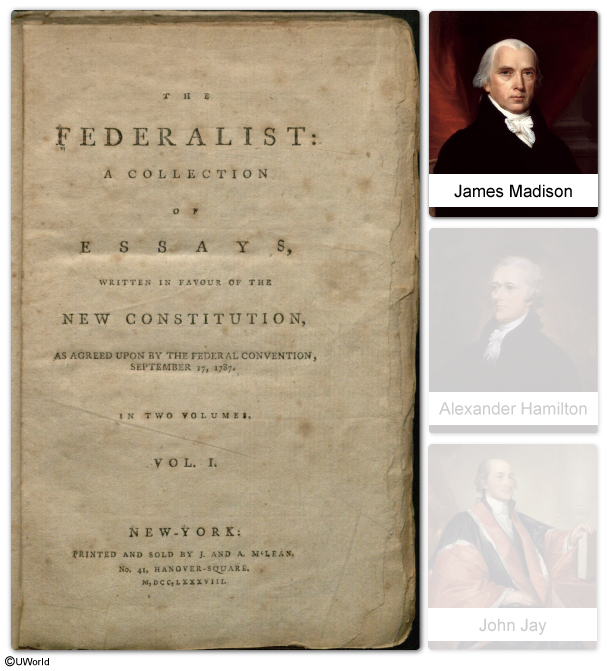
James Madison noted how some Anti-Federalist authors confused and misapplied the terms "republic" and "democracy." So, in The Federalist 14, Madison defined these terms and explained why Federalists endorsed republicanism, or government administered by representatives elected by the people.
One advantage of republicanism, Madison explained, is that it fosters a limited government by separating federal and state powers, such that community officials can manage local affairs. To this end, The Federalist 14 encouraged a limited government over a large area via elected representatives.
This arrangement is reflected in Madison's assurance to Anti-Federalists that states would "retain their due authority and activity." If the Constitution were to eliminate states' existing authority, Madison argued, the national government would lose its republican structure.
(Choice B) Following the republican ideal, the Constitution supported, rather than opposed, state legislators' authority to enact tax laws.
(Choice C) Although not expressed in The Federalist 14, Madison was concerned that the federal judiciary would be the weakest, not the strongest, branch of government.
(Choice D) Madison advocated separating, not combining, the three branches of government so that they could check and balance each other.
Things to remember:
Republicanism favors a limited government by
separating federal and state powers, such that community officials can manage local
affairs. Consequently, James Madison argued a republic is better able than a
democracy to govern a large area via elected representatives.
Passage
"If men were angels, no government would be necessary. In framing a government which is to be administered by men over men, the great difficulty lies in this: you must first enable the government to control the governed; and in the next place oblige it to control itself. A dependence on the people is, no doubt, the primary control on the government; but experience has taught mankind the necessity of auxiliary precautions. This policy of supplying, by opposite and rival interests, the defect of better motives, might be traced through the whole system of human affairs, private as well as public. We see it particularly displayed in all the subordinate distributions of power…."
Question
In The Federalist 51, James Madison described the need for a system of checks and balances to prevent any one branch of government from becoming too powerful. Which of the following best explains how Congress can check another branch?
| A. Congress can remove inferior officers in an executive agency for criticizing congressional members | |
| B. Congress can remove members of a president's cabinet for opposing a bill that is under debate | |
| C. Congress can remove ranking military officers if they are convicted of sedition or treason | |
| D. Congress can remove a federal district judge who is convicted of perjury or solicitation of bribes |
Explanation

In Morrison v. Olson (1988), the Supreme Court interpreted the removal clause, clarifying which positions qualify as 'civil officers' subject to congressional removal. The Court determined that federal civil officers are only Cabinet-level department heads, ambassadors, and federal judges; lower federal agency positions are instead regarded as 'inferior officers.'
Federal civil officers are subject to removal by Congress after impeachment by the House of Representatives and a trial in the Senate. Reasons for impeachment are vague and flexible, but the guidelines center on "treason, bribery, or other high crimes and misdemeanors"—the language of the removal clause.
Using the removal clause, Congress can check the judicial branch and remove federal judges for high offenses such as perjury or solicitation of bribes. As of August 2022, the House had impeached 15 federal judges, leading to 8 Senate convictions and 3 resignations.
(Choice A) Presidents or applicable department heads typically remove inferior officers in federal agencies.
(Choice B) Public opposition to a particular bill by Cabinet members is not an impeachable offense.
(Choice C) Instead of being subject to impeachment, military officers are disciplined based on military codes.
Things to remember:
As a check on the judicial branch, Congress can
remove federal judges via the removal clause for high crimes such as perjury or the
solicitation of bribes.
Interactions Among Branches of Government Practice Test
Passage
"The proposal I'm putting forth tonight for America's future will free us from the grip of special interests and create a binding commitment to the only special interest that counts—you, the people who pay America's bills. It will create millions of new jobs for working people, and it will replace the politics of envy with a spirit of partnership—the opportunity for everyone to hitch their wagon to a star and set out to reach the American dream.
I'll start by answering one question on your minds: Will our proposal help you? You bet it will. We call it America's tax plan because it will reduce tax burdens on the working people of this country, close loopholes that benefit a privileged few, simplify a code so complex even Albert Einstein reportedly needed help on his 1040 Form, and lead us into a future of greater growth and opportunity for all."
Question
President Ronald Reagan used a televised address to advance his agenda on tax reform. This is an example of the president's
| A. wartime powers | |
| B. appointment powers | |
| C. formal powers | |
| D. informal powers |
Explanation
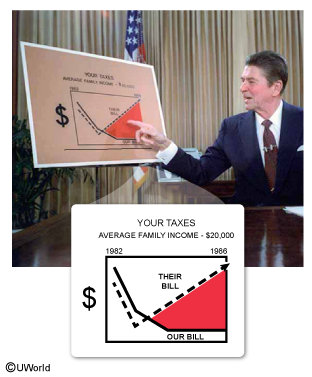
Compared to other politicians, US presidents receive a high level of media attention, giving the chief executive unmatched influence on political matters. The ability to use the mass media for political purposes, often called the "bully pulpit," is among the president's informal powers.
Coined by President Theodore Roosevelt, the term bully pulpit can be applied to any high political office, but it is generally used to refer to the special power of presidents. In Roosevelt's era, only print media existed. By the time Ronald Reagan became president, however, the bully pulpit included television, which he frequently used to build support for his economic policies.
(Choices A and B) The use of the mass media to promote an agenda exemplifies the president's informal power, not wartime or appointment powers.
(Choice C) A formal power, such as the veto, is based on the Constitution or a statute. In contrast, presidents' use of televised addresses to garner support for their agenda is considered an informal power.
Things to remember:
Known as the bully pulpit, the president's
ability to use the media to advance a policy agenda is an informal power of the nation's
chief executive.
Passage
Sometimes elections lead to a divided government and "lame-duck" presidencies that may slow or temporarily halt the workings of government. Which of the following situations is an example of a partisan divide disrupting the normal functioning of government?
| A. The Republican controlled Senate refusing to hold a confirmation hearing for President Obama's Supreme Court nominee Merrick Garland | |
| B. A majority conservative Supreme Court striking down key parts of the Affordable Care Act | |
| C. The Democratic House passing a sweeping infrastructure bill with bipartisan support | |
| D. Republican President G. W. Bush using the media to increase public support for the invasion of Iraq |
Explanation
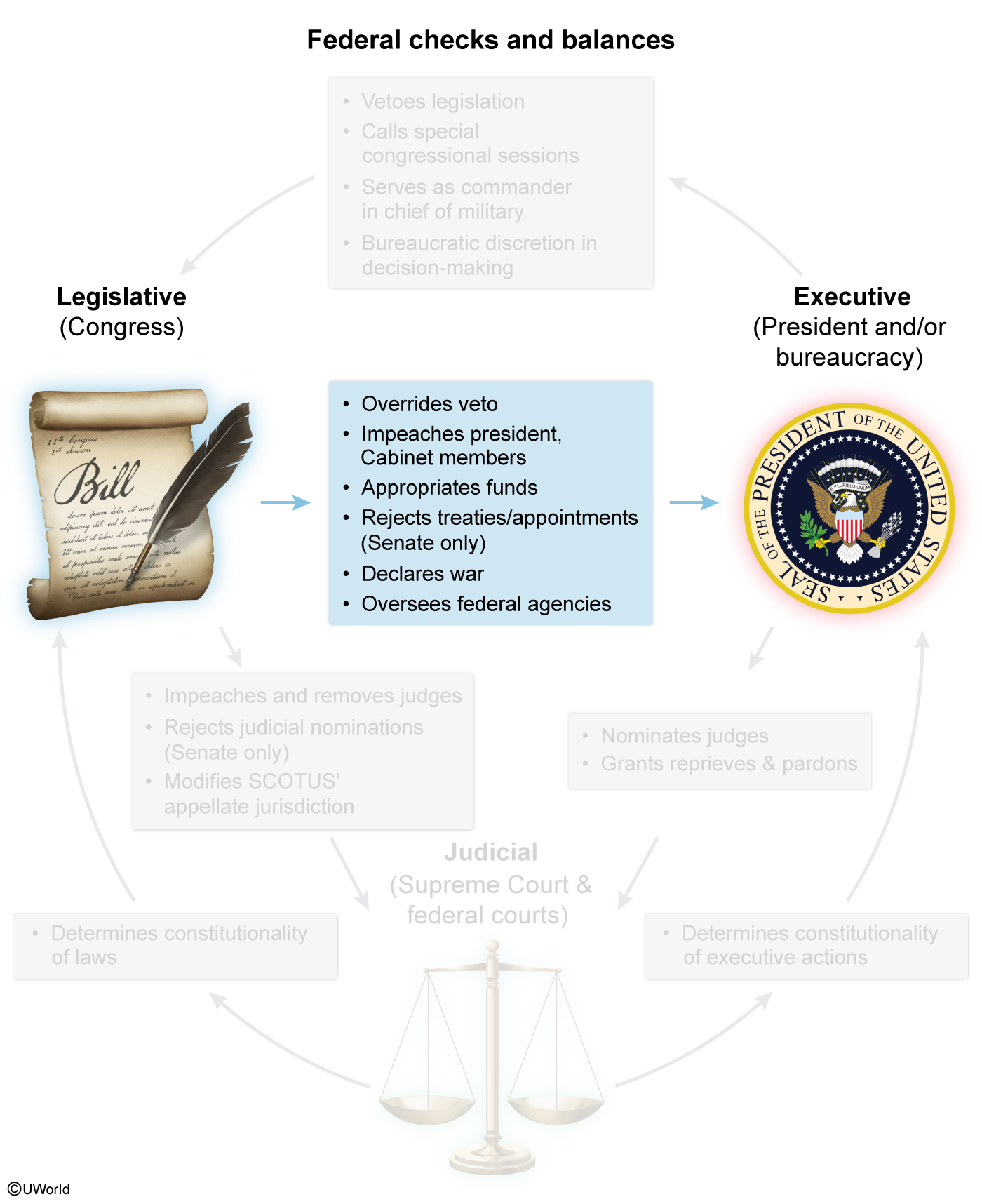
In 2014, elections for the 114th Congress gave the Republican Party control of both the House and the Senate. In February 2016, the last year of President Obama's second term, Justice Antonin Scalia died, creating a vacancy on the Supreme Court.
Obama quickly nominated Merrick Garland, but the Senate majority leader, Republican Mitch McConnell, refused to initiate the congressional confirmation process. McConnell blocked confirmation hearings for Obama's Supreme Court pick, keeping the seat open for a potential future nominee from his own party.
As a result, the Court operated for over a year with only 8 justices, lacking a tie breaker. In some instances, the Court's split-decisions effectively blocked initiatives, impacting millions of Americans. For example, in 2016 a 4-4 Court decision blocked an Obama's executive order to stop the deportation of 4 million long-time US residents without legal status.
(Choice B) A conservative majority in the Supreme Court striking down key parts of the Affordable Care Act reflects an ideological divide, but it didn't disrupt the normal functioning of government.
(Choice C) Bipartisan support for legislation is the opposite of a partisan divide in Congress.
(Choice D) The invasion of Iraq had bipartisan support in Congress, so this issue isn't an example a partisan divide in Congress and it didn't disrupt the normal functioning of government.
Things to remember:
In 2016, Republican Senate majority leader Mitch
McConnell's refused to initiate the confirmation process for the outgoing Democratic
president's Supreme Court nominee. As a result, the Court operated for over a year
with only 8 justices, lacking a tie breaker.
Question
Which of the following cases demonstrates how ideological changes over time in the composition of the Supreme Court led to the rejection of an existing precedent?
| A. Roe v. Wade (1973) | |
| B. Brown v. Board of Education (1954) | |
| C. United States v. Lopez (1995) | |
| D. Wisconsin v. Yoder (1972) |
Explanation
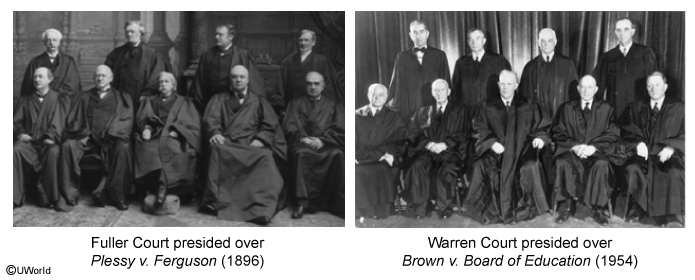
Compared with Congress and the executive, the Supreme Court is known for its consistency. When judicial change does occur, it is usually ideological, which can lead to establishing new precedents or rejecting existing ones.
For example, Brown v. Board of Education (1954) ended legal segregation in public schools. This ruling overturned the precedent in Plessy v. Ferguson (1896), which called for "separate but equal" facilities for Blacks. In 1896, the majority of the justices that made up the Fuller Court were conservative, whereas in 1954, the Warren Court had nine liberal judges.
With the overturning of Plessy by the liberal Warren Court, Brown demonstrates how Supreme Court ideologies can change over time, contributing to the rejection of an existing precedent.
(Choice A) Roe v. Wade (1973) upheld the right to privacy established in previous cases such as Griswold v. Connecticut (1965). Roe doesn't reflect how changes in the Court's ideological composition can lead to the rejection of an existing precedent.
(Choice C) United States v. Lopez (1995) stated that Congress had overstepped its authority with the Federal Gun-Free School Zone Act by violating the commerce clause. This ruling didn't overturn an existing precedent.
(Choice D) In Wisconsin v. Yoder (1972), the Court ruled that mandatory school attendance violated the First Amendment's free exercise clause. This case didn't reject an existing precedent.
Things to remember:
Brown v. Board of Education (1954)
demonstrates how the ideological composition of the Supreme Court changes over time,
occasionally contributing to the rejection of an existing precedent.
Civil Liberties and Civil Rights Practice Test
Question
Which of the following Supreme Court cases established that the Second Amendment right to keep and bear arms for self-defense in one's home is applicable to the states through the Fourteenth Amendment?
| A. McDonald v. Chicago | |
| B. Baker v. Carr | |
| C. Gideon v. Wainwright | |
| D. Schenck v. United States |
Explanation
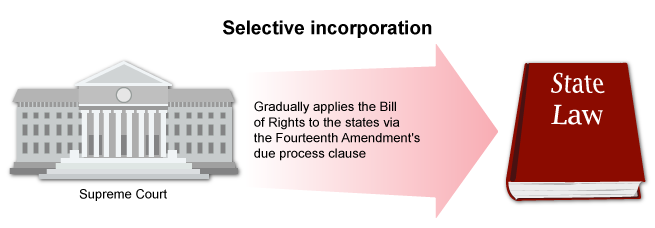
In 2008 Otis McDonald was denied a permit for a handgun intended for home protection due to a Chicago ordinance restricting gun ownership. McDonald became the lead litigant in a suit arguing that the ordinance violated the Second Amendment. At the time, the Second Amendment only offered protection against the federal government's infringement on rights of gun owners.
In McDonald v. Chicago (2010), the Supreme Court upheld its previous ruling in District of Columbia v. Heller (2008) determining that citizens have a fundamental right to keep and bear arms for self-defense. In the McDonald ruling, however, the Court also made Second Amendment protections applicable to the states through a process known as selective incorporation.
McDonald v. Chicago established that the Second Amendment right to keep and bear arms in one's home for self-defense is applicable to the states through the Fourteenth Amendment.
(Choice B) Baker v. Carr (1962) concerns political redistricting, not the right to bear arms.
(Choice C) Gideon v. Wainwright (1963) made the Sixth Amendment, not the Second Amendment, applicable to the states.
(Choice D) Schenck v. United States (1919) is a First Amendment case and is unrelated to the right to bear arms.
Things to remember:
In McDonald v. Chicago (2010), the
Supreme Court established that the Second Amendment right to keep and bear arms for
self-defense is applicable to the states through the Fourteenth Amendment.
Passage
"Allowing the broadest scope to the language and purpose of the Fourteenth Amendment, it is well understood that the right of free speech is not absolute at all times and under all circumstances. There are certain well-defined and narrowly limited classes of speech, the prevention and punishment of which has never been thought to raise any Constitutional problem. These include the lewd and obscene, the profane, the libelous, and the insulting or 'fighting' words—those which by their very utterance inflict injury or tend to incite an immediate breach of the peace.…
The test is what men of common intelligence would understand would be words likely to cause an average addressee to fight…. The English language has a number of words and expressions which by general consent are 'fighting words' when said without a disarming smile…. Such words, as ordinary men know, are likely to cause a fight. So are threatening, profane or obscene…. Derisive and annoying words can be taken as coming within the purview of the statute as heretofore interpreted only when they have this characteristic of plainly tending to excite the addressee to a breach of the peace.…
A statute punishing verbal acts, carefully drawn so as not unduly to impair liberty of expression, is not too vague for a criminal law."
Question
The Supreme Court ruled in Chaplinsky v. New Hampshire (1942) that a "statute punishing verbal acts, carefully drawn so as not unduly to impair liberty of expression, is not too vague for a criminal law." Which of the following is most relevant to that decision?
| A. McCulloch v. Maryland (1819) | |
| B. The Fifth Amendment | |
| C. Schenck v. United States | |
| D. Prior restraint |
Explanation
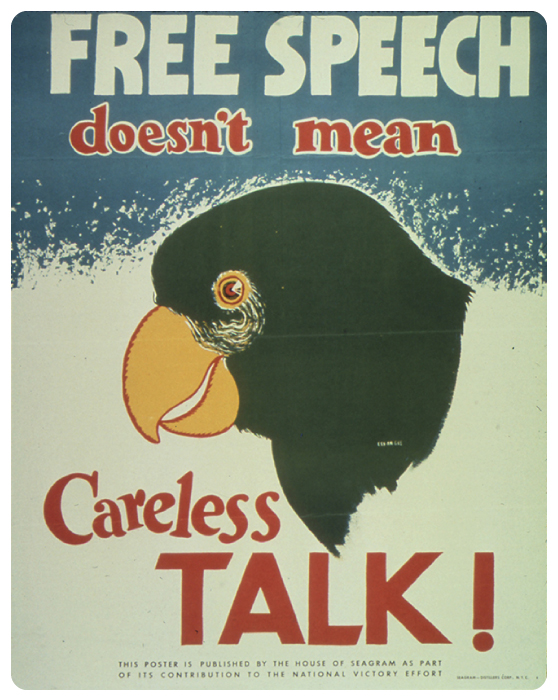
In Schenck v. United States (1919), the Supreme Court upheld the Espionage Act (1917), which criminalized speech that posed a threat to national security. The Court established the "clear and present danger" test to determine when the government may criminalize some speech.
The Schenck decision affirmed the constitutionality of laws criminalizing speech that threatens public safety or disrupts the peace. In Chaplinsky v. New Hampshire (1942), the Court used the same reasoning applied to the Schenck decision to determine the constitutionality of state laws criminalizing speech is likely to "incite an immediate breach of peace."
(Choice A) McCulloch v. Maryland (1819) affirmed the necessary and proper clause and isn't related to free speech.
(Choice B) The Fifth Amendment protects the rights of the accused and isn't the most relevant to the decision in Chaplinsky.
(Choice D) Prior restraint refers to preemptive bans by speech, while statutes punishing verbal acts deal with punishing speech after it has occurred.
Things to remember:
The Schenck decision affirmed the
constitutionality of laws criminalizing speech that is likely to breach the peace.
Question
In New York Times Co. v. United States (1971), the Supreme Court struck down injunctions against the Times' continued publication of the Pentagon Papers because
| A. the documents reflected poorly on earlier presidents' strategies in Vietnam | |
| B. freedom of the press was incorporated into state laws via the Fourteenth Amendment | |
| C. the government failed to demonstrate that national security was compromised | |
| D. Pentagon officials provided clearance to the Times' editors to publish the documents |
Explanation
In 1971, a classified set of government documents on the Vietnam War—known as The Pentagon Papers—was leaked to the New York Times (NYT), which began publishing it. Concerned about the disclosure of state secrets, the government obtained an injunction that prevented the NYT's continued publication of the report—an action known as prior restraint.
The Supreme Court has often affirmed the government's compelling interests regarding national security when restricting freedom of the press. However, in New York Times Co. v. US, the Court sided with the newspaper, noting that the government failed to demonstrate that publishing The Pentagon Papers would compromise national security.
The Court's ruling affirmed that there is a heavy presumption against the government's use of prior restraint and that an equally heavy burden must be met to justify its use.
(Choice A) The Court ruled the government failed to justify prior restraint as a compelling national security interest in The Pentagon Papers' publication, not because of its poor reflection on previous presidents' strategies.
(Choice B) NYT Co. v. US was a federal case, so the incorporation of freedom of the press—an outcome of Gitlow v. New York (1925)—wasn't a factor in the ruling.
(Choice D) The Pentagon Papers were leaked; Pentagon officials didn't provide clearance for their publication.
Things to remember:
In New York Times Co. v. United States
(1971), the Supreme Court struck down injunctions against a newspaper because the government
failed to demonstrate that national security was compromised.
American Political Ideologies and Beliefs Practice Test
Passage
Question
The graph illustrates massive government expenditures in 1936, the year that President Franklin D. Roosevelt was reelected by carrying 46 states and winning 523 electoral college votes. Which of the following is most directly related to Roosevelt's landslide victory in the 1936 election?
| A. The support of the Supreme Court in ruling that the president's economic recovery programs were all constitutional | |
| B. The emergence of laissez-faire economics to support businesses and reduce joblessness | |
| C. The confiscation of citizens' gold to end hoarding and converting gold into paper money | |
| D. The success of liberal policies in combating poverty during the country's economic downturn |
Explanation
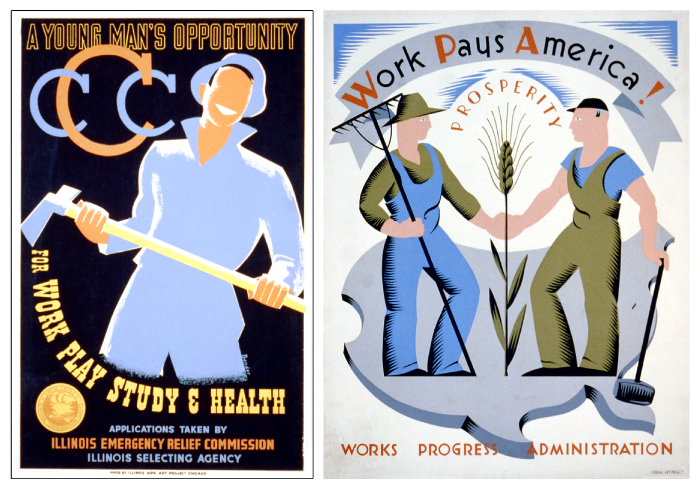
During the Great Depression, millions of Americans became impoverished as banks collapsed, layoffs became widespread, and jobs dried up. To address growing poverty, President Franklin D. Roosevelt (FDR) instituted New Deal programs to confront the social issue of joblessness.
Massive deficit spending was required to fund programs like the Civilian Conservation Corps and the Works Progress Administration. These and other liberal policies during the Great Depression improved millions of Americans' economic security and led to FDR's landslide victory in the 1936 election.
(Choice A) The Supreme Court ruled that two key New Deal programs—the National Recovery Act and the Agricultural Adjustment Act—were unconstitutional.
(Choice B) FDR's New Deal involved a high degree of economic planning—not laissez-faire economics, a hands-off approach to the economy that emerged in the mid-18 th century.
(Choice C) FDR's administration authorized the confiscation of gold through an executive order in 1933. However, this policy was widely unpopular, so it wouldn't have contributed to FDR's electoral success in 1936.
Things to remember:
Beginning in 1933, New Deal programs confronted
poverty by helping to reduce the nation's unemployment rate. The success of these
liberal policies was directly related to President Franklin D. Roosevelt's landslide
reelection victory in 1936.
Passage
"The settlers who established themselves on the shores of New England all belonged to the more independent classes of their native country. Their union on the soil of America at once presented the singular phenomenon of a society containing neither lords nor common people, neither rich nor poor."
Question
Which of the following constitutional amendments is most related to the author's vision of the United States as an egalitarian society?
| A. Thirteenth Amendment | |
| B. Seventeenth Amendment | |
| C. Eighteenth Amendment | |
| D. Twenty-First Amendment |
Explanation
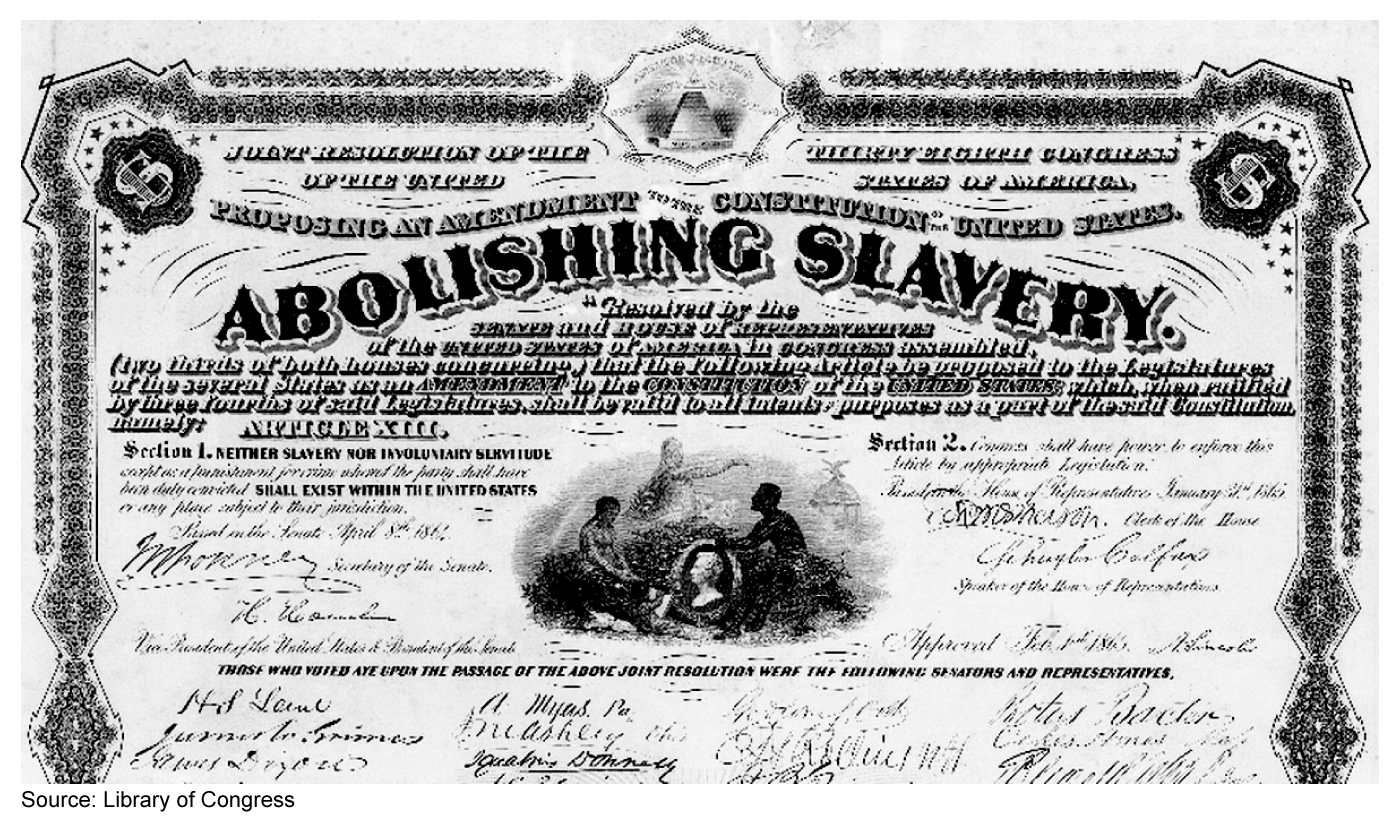
Slavery and forced servitude existed in the US when Alexis de Tocqueville—an abolitionist—arrived in 1831. Although troubled by slavery's existence, Tocqueville praised the degree to which the US was egalitarian (equal), enabling citizens to improve their social status.
Decades after Tocqueville returned to France, slavery and forced servitude were abolished by the Thirteenth Amendment. Through this and other Reconstruction Amendments, former slaves were recognized as citizens with natural rights and deserved equal protection under the law. Therefore, the Thirteenth Amendment relates to Tocqueville's egalitarian vision of the US.
(Choice B) The Seventeenth Amendment established that senators would be determined by popular vote.
(Choices C and D) Tocqueville's egalitarian vision doesn't relate to the Eighteenth Amendment's prohibition of alcohol—later repealed by the Twenty-First Amendment.
Things to remember:
Abolishing slavery via the Thirteenth Amendment
was crucial to developing a more equal society, one that embodied Tocqueville's
egalitarian vision of the US.
Question
The Declaration of Independence proclaims that all people "are endowed by their Creator with certain unalienable rights, [and] that among these are life, liberty, and the pursuit of happiness." Which of the following statements represents a reason for this pronouncement?
| A. Individualism is a core value underlying American political life | |
| B. Ensuring basic material well-being is a fundamental purpose of government | |
| C. The founders established a political structure based on religious principles | |
| D. Forbidding capital punishment is a necessary guard against government tyranny |
Explanation

Individualism, the principle that people freely determine their own actions and beliefs, was central to Enlightenment political thought. Its influence on early Americans is reflected in the founding documents emphasizing individual rights and liberties, thus establishing individualism as a core value underlying American political life.
For example, the Declaration of Independence proclaims that all people "are endowed by their creator with certain unalienable rights, [and] that among these are life, liberty, and the pursuit of happiness." The founders justified separation from English rule as a result of this emphasis on individual rights, which also prompted state and national bills of rights.
Like other founding documents such as the Constitution, the Declaration of Independence does not support a government that:
-
(Choice B) ensures basic material well-being; however, it promotes ensuring an individual's right to pursue well-being.
-
(Choice C) establishes a political structure based on religious principles, despite its acknowledgement of a "Creator" of humankind.
-
(Choice D) forbids capital punishment (the death penalty), as suggested, for example, by the lack of a ban on capital punishment in either the Articles of Confederation or the Constitution.
Things to remember:
The Declaration of Independence reflects the core
American value of individualism by emphasizing each person's rights to life, liberty, and
the pursuit of happiness.
Political Participation Practice Test
Question
A person claiming that voter turnout is higher in presidential elections than in midterm elections is most likely to cite which of the following electoral differences as the cause of this trend?
| A. States that allow same-day voter registration for presidential elections typically do not allow it for midterm elections | |
| B. Because Senate terms are staggered, the only congressional contests in any midterm election are for one-third of all Senate seats | |
| C. There is greater voter engagement during presidential elections than during midterm elections | |
| D. Midterm elections in most states require party membership, lowering independent voter turnout |
Explanation
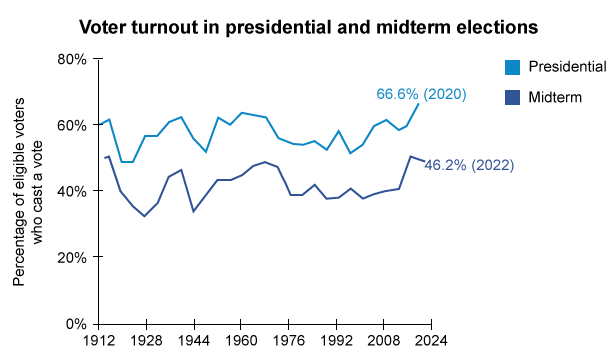
Americans elect officials at national, state, and local levels of government and often vote on state and local ballot measures. Because these elections commonly occur at different times, many Americans experience voter fatigue, which lowers voter turnout. However, people are more likely to vote when they are politically engaged.
Voter engagement is higher among those who believe that the outcome of an election will affect them. Media coverage heightens engagement by increasing exposure to candidates and policy issues that potential voters care about. Because of the national reach of the presidency, voter engagement and media coverage for presidential elections are higher than for other elections, including midterms.
Someone claiming that voter turnout is higher in presidential elections than in midterm elections is therefore likely to cite greater voter engagement as a cause.
(Choice A) Most states that allow same-day voter registration do so for both presidential and midterm elections.
(Choice B) Although Senate terms are staggered, the entire House is elected every two years. Therefore, all states have congressional races in each midterm election as well as in each presidential election year.
(Choice D) Primary elections and caucuses may be closed, requiring party membership, but midterm elections are not.
Things to remember:
A major reason that voter turnout is higher in
presidential elections is greater voter engagement, which results, in part, from increased
media coverage.
Question
A state's congressional districts are redrawn following a national census. Rather than try to equalize the number of voters from opposing parties when drawing districts, the state legislature instead draws most districts in a way that results in its majority party being more highly represented among voters. Which of the following is the most likely effect of this type of redistricting?
| A. In most districts, voter turnout in the general election will be higher than before redistricting occurred | |
| B. In most districts, there will be an increase in the number of third-party candidates who run in the primary election | |
| C. In most districts, the primary election will be more competitive than the general election | |
| D. In most districts, the Republican candidate will win the general election |
Explanation
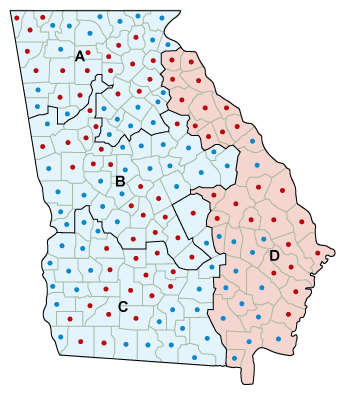
In many states, the legislature's majority party practices gerrymandering, drawing congressional district boundaries to give the party an electoral advantage. The map above shows that Districts A, B, and C have been drawn to "pack" Blue Party voters, giving the advantage to Blue Party candidates in those districts. In contrast, District D has been drawn to advantage Red Party candidates.
Partisan gerrymandering often results in uncompetitive general election races. However, primary elections may be highly competitive in districts where a party is virtually sure to win because that party's candidates—knowing they may run uncontested in the general election—vie for the party's nomination. Therefore, in gerrymandered districts, primaries tend to be more competitive than general elections.
(Choice A) Gerrymandering tends to decrease, rather than increase, voter turnout because it produces less competitive elections in which voters feel their votes won't matter.
(Choice B) Because gerrymandered districts favor major-party candidates, third-party candidates are unlikely to run in those districts' primaries.
(Choice D) Because the scenario doesn't identify which party controls the legislature, it can't be concluded which party would have the electoral advantage.
Things to remember:
In gerrymandered districts, congressional primary
elections are likely to be more competitive than general elections.
Question
Two cable television networks are competing for viewers of political programming. One network features commentary that aligns with liberal viewpoints, while the other appeals to conservative perspectives. A critic of the influence of ideologically driven media would make which of the following claims?
| A. The liberal-leaning network will feature an imbalance of political content that positively characterizes Republican officeholders | |
| B. The conservative-leaning network will reject regulatory requirements that must be met before airing criticism of federal officials | |
| C. The networks will reinforce political polarization by presenting biased coverage that targets specific audiences | |
| D. The networks will regularly include opposing ideological viewpoints in their programming to expand viewership |
Explanation

To maximize profits, media platforms increasingly target specific ideological audiences, delivering content that appeals to consumers' biases and minimizes competing perspectives. This programming fosters "echo chambers" in which audiences consume news and opinions that reinforce, rather than challenge, their ideological beliefs.
Critics of ideologically driven media often argue that biased coverage reinforces political polarization. Consequently, this polarization narrows political dialogue, limiting opportunities for shared understanding among policymakers and voters.
(Choice A) A liberal-leaning network would not likely present Republican officeholders, who typically express conservative preferences, in a favorable light.
(Choice B) The First Amendment ensures that prior restraint of media criticism of government officials, such as through regulations, is unconstitutional.
(Choice D) Ideologically driven programming typically avoids presenting opposing ideological viewpoints, which could risk losing targeted viewers and advertising revenues.
Things to remember:
Ideologically driven media coverage reinforces
political polarization by appealing to specific ideological audiences, limiting exposure to
competing perspectives.
Make the AP Government Exam Feel Like Practice
Our AP Gov practice tests and quizzes, which cover both MCQs and FRQs*, teach you to spot trick answers, handle time pressure, and build real confidence. Practice with realistic exam simulations so test day feels like just another practice run.
One-Click AP Gov Quizzes
Practice Under Real Exam Conditions
Study with Exam-Aligned Questions
Achieve Higher AP Gov Exam Scores with Smart Study Tools
Exceptional Explanations for AP Gov Practice Questions
Understand the “why” with our simplified breakdowns of how to approach each question and topic. Our clear question explanations and vivid visuals help you spot and avoid trick answers so you’ll ace the AP U.S. Government exam. Our exclusive technique, backed by cognitive learning principles, maximizes learning and retention.
Flashcards & Notes That Help You Actually Remember
Create digital flashcards to practice the concepts you struggle with most, like the checks and balances system or the difference between civil rights and civil liberties, helping you remember information months later, not just for the next unit quiz. Use My Notebook to organize key concepts from AP Gov practice questions in the format that works best for you, whether that’s bullet points for the arguments in Federalist No. 10 vs. Brutus No. 1, diagrams showing the process of selective incorporation, or detailed notes on the required Supreme Court cases like Marbury v. Madison. One-click transfer from explanations to your flashcards or notebook means everything you need stays in one organized place.
Track Your Progress & Target Weak Spots
See exactly where you stand with detailed performance tracking across all your AP Government practice tests and practice questions. Our analytics dashboard shows which topics you're crushing and which ones need more work. Focus your study time on actual weak areas, stop wasting time on stuff you already know, and watch your scores improve.
Pick Your AP Government Prep Package
Pick Your AP Government Prep Package
AP Government Practice Tests
Starting at $39
250+ AP Government Practice Questions (MCQs)
Custom AP Government Practice Tests & Quizzes
Progress Tracking Dashboard
Pick Your Study Topics
Smart Study Planner
Realistic FRQ Practice with Scoring Guide*
250+ AP Government Practice Questions (MCQs)
Custom AP Government Practice Tests & Quizzes
Progress Tracking Dashboard
Pick Your Study Topics
Smart Study Planner
Realistic FRQ Practice with Scoring Guide*
Score-Predicting Full-Length AP Government Mock Exam*
Print and Digital Study Guide
150+ Check-for-Understanding Questions
Expert-led Video Lessons
AP Government Practice Test Reviews
UWorlds multiple choice questions are similar to the ones on the official AP exam and allowed me to time myself for each question. This was very helpful for me as I was able to answer questions faster and could finish the questions on the actual exam. The explanations for each question went in-depth and gave important details pertaining to events in the timeline. Through this, I was able to gain important skills for the exam and get a 5.
See MoreBefore, I had a hard time studying and staying focused because it was just boring, but now with UWorld, not only can I focus, but I actually feel motivated to learn!
The explanations were clear and I could practice the question based on units. I got a 5 in the end!! So, I think it’s very helpful and I’ll be using it to study for my future exams 🙂 You guys provide so many different functions to help students like me, and I really appreciate it, it’s really worth the money.
See MoreAP Government Practice Tests & Questions: Frequently Asked Questions (FAQs)
How closely do UWorld's AP Government practice tests mirror the real AP exam?
Why choose UWorld's AP Gov practice questions over free materials online?
Many free AP Government practice questions you find online can be outdated, contain errors, or lack meaningful explanations. Our AP Gov practice test platform provides a comprehensive study system. You get:
- Hundreds of high-quality, exam-accurate AP Gov practice questions
- Custom AP Gov practice test and quiz generator
- Detailed answer rationales for every question to help you master the material
- A performance dashboard to pinpoint your weaknesses
Does the UWorld AP US Government practice test bank cover all required units?
Yes. Our AP US Government practice question bank is comprehensive, covering all units and topics from the official College Board curriculum including:
- Unit 1: Foundations of American Democracy
- Unit 2: Interactions Among Branches of Government
- Unit 3: Civil Liberties and Civil Rights
- Unit 4: American Political Ideologies and Beliefs
- Unit 5: Political Participation
What is the best way to use AP Government practice questions to aim for a 5?
Begin by using the AP Gov practice exam generator to take short unit specific quizzes to identify your knowledge gaps. After each assessment review the explanations for all questions, even those you answered correctly to solidify your understanding. Our detailed rationales are what set UWorld apart and help you grasp the “why” behind each answer.
When is the best time to start using AP US Government practice questions?
Can I create my own AP Gov practice test focused on specific topics?
Absolutely. Our AP Gov practice test builder allows you to generate unlimited custom quizzes tailored to specific units like Civil Liberties or the branches of government. Our next level customization allows you to even drill down into more granular topics.
